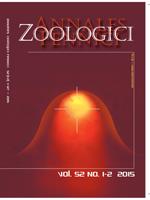The wolf (Canis lupus) population in Finland is recolonizing its former range after an absence of about 100 years. During its absence, the boreal forest environment has been significantly altered by humans and has become a patchwork of managed forests and human-modified areas. Wolf recolonization has raised a need for information on the potential occurrence of wolf home ranges and habitat requirements. We used a logistic regression to compare a set of habitat features inside 20 known minimum convex polygon (MCP) home ranges of wolves in Finland with the same habitat features in random areas. Wolves tended to show strong avoidance of direct human presence. There did not appear to be a large difference in the occurrence of different forest types between wolf home ranges and random areas. An independent sample of ten wolf home ranges was used to evaluate the probabilities of wolf occurrence predicted by the models. According to our model, 90% of these home ranges had a probability of occurrence greater than 0.50. We also used logistic regression to compare the habitat composition of 50% kernels inside the MCP home ranges. The tendency to avoid human presence was also evident in smaller scale habitat selection.
How to translate text using browser tools
1 April 2015
Habitat Model for a Recolonizing Wolf (Canis lupus) Population in Finland
Salla Kaartinen,
Harri Antikainen,
Ilpo Kojola
ACCESS THE FULL ARTICLE

Annales Zoologici Fennici
Vol. 52 • No. 1–2
April 2015
Vol. 52 • No. 1–2
April 2015




